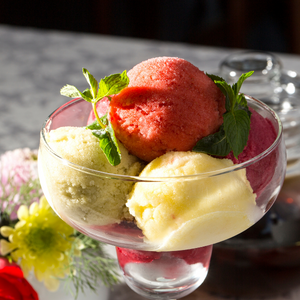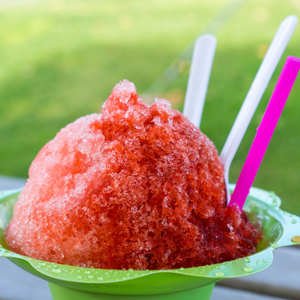From ice cream to frozen custard, the number of desserts out there is nearly endless. Whether it’s hot or cold outside, you can always enjoy a frozen treat. Enjoy any and many of the following frozen treats at your next picnic, catering event, or party!
Ice Cream
Ice cream is perhaps the most common frozen dessert. Commonly served in cones, bowls, or soft serve, ice cream has a lot of nuance to it. The number of flavorings used in ice cream is nearly endless, with some common ones being:
- Vanilla
- Chocolate
- Banana
- Strawberry
- Nutella
- Oreo
History Of Ice Cream
Ice cream has its origins in Ancient Asia, with the most commonly quoted source for ice cream appearing in Europe being Marco Polo. He brought it back from his journeys into distant East Asia, meaning ice cream is at least 700 years old in the Western world.
Before modern refrigeration, ice cream was made with ice harvested in winter. Generally, ice would be crushed and placed in a bowl, as in a double bowl assembly, and the cream and other ingredients would be stirred as they cooled.
How To Make Ice Cream
Ice cream is made from cream, sweeteners, and flavorings. Ice cream is frozen and stirred to prevent large ice crystals from forming. These days, ice cream is typically made by mixing the ingredients in a machine that cools the ice cream as it mixes it, avoiding the formation of large ice crystals. Additionally, air is heavily incorporated into the production process. The result is the malleable, frozen semi-solid foam we know as ice cream.
Gelato vs. Ice Cream
The primary differences between gelato and ice cream are the fat and the
air content. Ice cream contains a minimum of 10% fat, whereas gelato has
no higher than 8% fat. Ice cream also contains up to 50% air by volume,
while gelato only has 25% air by volume, meaning gelato is denser than
conventional ice cream. 
Frozen Yogurt
Frozen yogurt is a dessert enjoyed by many. It is made from most of the same ingredients as ice cream; however, there are two critical differences setting them apart. To make frozen yogurt, you would use milk instead of cream. And unlike ice cream, frozen yogurt has live bacterial cultures in it.
Now don’t worry, these aren’t the type of bacteria that make you sick. This bacteria is used to ferment dairy products such as kefir, cheese, and traditional yogurt.
History Of Frozen Yogurt
Frozen yogurt came to prominence in the 1970s. A businessman named H.P. Hood introduced frozen yogurt to the world, and it soon took off after that. It was invented in response to a request for a low-fat frozen dessert from Bloomingdale's department stores. The invention quickly took off, with numerous frozen yogurt chains opening up soon after.
How To Make Frozen Yogurt
Frozen yogurt is generally made by mixing all the milk solids together
with the bacterial culture. After this mixture has homogenized, the
frozen yogurt is cooled to its final temperature. Then, sweeteners and
flavorings are added last to the frozen yogurt. The result is the frozen
yogurt that we all know and love. 
Sorbet
Sorbet differs from ice cream in that it is generally produced without cream, and consists of just ice and sugar-sweetened water with various flavorings added. Sorbet is a light dessert made with fruit juices and puree as flavorings. A favorite of famed French chef Escoffier, this frozen dessert has a long history.
History Of Sorbet
Sorbets go way back to Ancient Persia, with some accounts of sorbet-like desserts dating back to 550 B.C. Sorbets are made out of water, sugar, and various fruit juices. Many individuals describe sorbet as a light dessert.
How To Make Sorbet
Sorbets can be made simply by mixing sugar, water, and fruit flavorings and freezing the mixture. Sorbets are made with fruits and fruit juices as flavorings, lending their natural flavor to the frozen concoction. The Romans would sweeten their sorbet-like desserts with honey, a practice with which many continue to engage in the modern day. Overall, sorbets are a delicious frozen dessert that can be prepared with minimal materials.
Sorbet vs. Sherbet
You may be asking yourself, “what’s the difference between sorbet and
sherbet?” The difference is that sherbet has dairy in it while sorbet
doesn’t. Sherbet is a mixture of sugar, water, and fruit flavoring just
like a sorbet, but with a small amount of milk added. This milk
contributes to the smoothness of sherbet, while sorbet is considerably
lighter due to the lack of dairy. 
Shaved Ice
Shaved ice is a common frozen dessert, particularly at carnivals and fairgrounds. It is produced with just crushed ice and a variety of flavored syrups. There are many versions of shaved ice belonging to a variety of national cuisines. Ranging from Korean "Bingsu" to Bolivian "Shikashika," the proliferation of shaved ice desserts is worldwide.
History Of Shaved Ice
The first documented shaved ice dessert came in 27 B.C. when the Roman Emperor Nero ordered slaves to collect snow from nearby mountains. He then had it flavored with fruit and honey. Since then, the dessert has become extremely popular in a variety of forms such as slushies, snow cones, and Hawaiian Ice.
How To Make Shaved Ice
In the past, shaved ice was made from snow collected from mountains or ice hammered with mallets and chisels. Typically, shaved ice is made with a shaved ice machine, which consists of a motor and a crushing mechanism to shred all the available ice to a fine powder consistency. Then a sweet syrup, typically fruit-flavored, is poured on top of the ice.
Slushie vs. Snow Cone
While there are various forms of shaved ice, perhaps the most popular
are slushies and snow cones. These shaved ice frozen desserts rely on
the particle size of the ice and the process of freezing the ice to
differentiate between the two. The ice used to make slushies is frozen
while mixed with its flavored syrup, resulting in a small particle size
for the ice. This is as compared to a snow cone, in which the ice
particle size is larger, and the ice is frozen before the addition of
flavored syrups. 
Frozen Custard
Frozen custard is a delectable dairy treat made similarly to ice cream. The main difference between frozen custard and ice cream is that frozen custard contains eggs. Available at specialty stores and concession stands all over the country, frozen custard remains an excellent treat for a hot day!
History Of Frozen Custard
Frozen custard was created in the 1690s when ice cream recipes called for the addition of egg yolks. The desert rose in popularity in the early 20th century in the U.S. with frozen custard's debut at Coney Island in 1919 and at the 1933 Chicago World's Fair.
How To Make Frozen Custard
The production process of frozen custard is similar to ice cream. To make frozen custard, you would mix cream, sugar, flavorings, and egg yolks while they are cooled. A critical difference between frozen custard and ice cream is the relatively low quantity of air in frozen custard. Soft serve ice creams often consist of 50% air by volume. However, frozen custard does not have air added in the production and is denser than conventional ice cream.
Frozen Custard vs. Concrete
The difference between frozen custard and a concrete dessert is
relatively simple. A concrete is frozen custard with solid ingredients,
such as chocolate, butterscotch, pieces of cake, or cookies added and
mixed in thoroughly. 
Milkshake
Milkshakes are frozen desserts made with milk, ice cream, and a variety of other toppings like chocolate or butterscotch. The history of milkshakes is intimately linked with the history of the blender, as milkshakes are not commonly produced without one.
History Of Milkshakes
The term milkshake was first used in print in 1885 to refer to an eggnog type of drink made with whiskey and eggs. The term would persist to exist throughout the late 19th century, referring to drinks made with chocolate or vanilla syrup by the 1900s. In the modern sense of the word, the first true milkshakes date to around 1910, when blenders were first popularized. In the 1950s, milkshakes became popular in soda shops around the country, a common meeting place for students, which led to further nationwide popularity.
How To Make A Milkshake
Milkshakes today are made by blending ice cream and milk in a blender,
either in the presence of or garnished with sprinkles, chocolate,
butterscotch, or maraschino cherries. Milkshakes are distinct from other
dairy-containing frozen desserts in both consistency and composition.
While milkshakes use ice cream as an ingredient, they also use milk.
Additionally, milkshakes have a liquid-like consistency, and they are
typically drunk with straws rather than eaten with spoons like most
frozen desserts.
It’s Time To Enjoy A Frozen Dessert!
There is a wide assortment of frozen desserts available and numerous variations of each type. Frozen desserts are most often enjoyed on hot days, but there’s no reason you can’t enjoy a cold snack on mild or even cool days. Now that you know the differences between each type of frozen dessert, it’s time for you to enjoy them!








